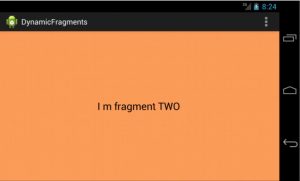
Today we try add Fragment layout in another Activity layout, that reduce complexity develop user interface. For this example we need 3 layout: main.xml, fragment1.xml, fragment2.xml, and 3 classes: MainActivity.java, Fragment1.java, Fragment2.java
Code of xml layouts
<LinearLayout xmlns:android="http://schemas.android.com/apk/res/android"
xmlns:tools="http://schemas.android.com/tools"
android:id="@+id/LinearLayout1"
android:layout_width="match_parent"
android:layout_height="match_parent"
android:orientation="horizontal" >
</LinearLayout>
<?xml version="1.0" encoding="utf-8"?>
<LinearLayout xmlns:android="http://schemas.android.com/apk/res/android"
android:layout_width="match_parent"
android:layout_height="match_parent"
android:orientation="vertical" >
<TextView
android:id="@+id/textView1"
android:layout_width="fill_parent"
android:layout_height="fill_parent"
android:text="I m fragment ONE"
android:gravity="center"
android:background="#5eff6a"
android:textAppearance="?android:attr/textAppearanceLarge" />
</LinearLayout>
<?xml version="1.0" encoding="utf-8"?>
<LinearLayout xmlns:android="http://schemas.android.com/apk/res/android"
android:layout_width="match_parent"
android:layout_height="match_parent"
android:orientation="vertical" >
<TextView
android:id="@+id/textView1"
android:layout_width="fill_parent"
android:layout_height="fill_parent"
android:text="I m fragment ONE"
android:gravity="center"
android:background="#5eff6a"
android:textAppearance="?android:attr/textAppearanceLarge" />
</LinearLayout>
Code of Java — classes
package com.example.dynamicfragments;
import android.support.v7.app.ActionBarActivity;
import android.app.Fragment;
import android.app.FragmentManager;
import android.app.FragmentTransaction;
import android.os.Bundle;
import android.view.Display;
import android.view.Menu;
import android.view.MenuItem;
import android.view.WindowManager;
public class MainActivity extends ActionBarActivity {
@Override
protected void onCreate(Bundle savedInstanceState) {
super.onCreate(savedInstanceState);
setContentView(R.layout.main);
FragmentManager fm = getFragmentManager();
FragmentTransaction fragmentTransaction = fm.beginTransaction();
// get the display mode
int displaymode = getResources().getConfiguration().orientation;
if (displaymode == 1) { // it portrait mode
Fragment1 f1 = new Fragment1();
fragmentTransaction.replace(android.R.id.content, f1);
} else {// its landscape
Fragment2 f2 = new Fragment2();
fragmentTransaction.replace(android.R.id.content, f2);
}
fragmentTransaction.commit();
}
}
package com.example.dynamicfragments;
import android.app.Fragment;
import android.os.Bundle;
import android.view.LayoutInflater;
import android.view.View;
import android.view.ViewGroup;
public class Fragment1 extends Fragment {
public View onCreateView(LayoutInflater inflater, ViewGroup vg,
Bundle savedInstanceState) {
return inflater.inflate(R.layout.fragment1, vg, false);
}
}
package com.example.dynamicfragments;
import android.app.Fragment;
import android.os.Bundle;
import android.view.LayoutInflater;
import android.view.View;
import android.view.ViewGroup;
public class Fragment2 extends Fragment {
public View onCreateView(LayoutInflater inflater, ViewGroup vg,
Bundle savedInstanceState) {
return inflater.inflate(R.layout.fragment2, vg, false);
}
}
Conclusion result for this example




